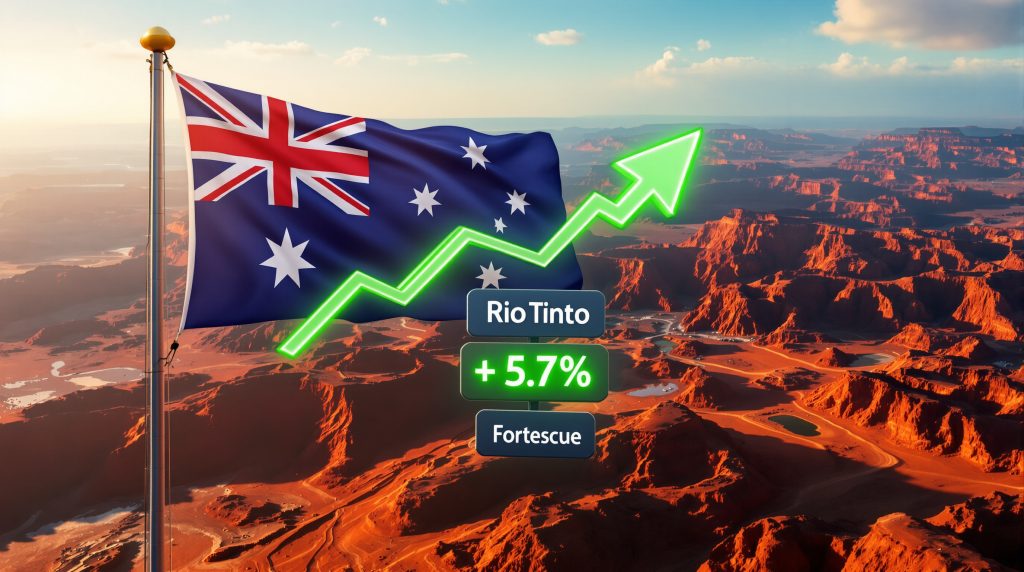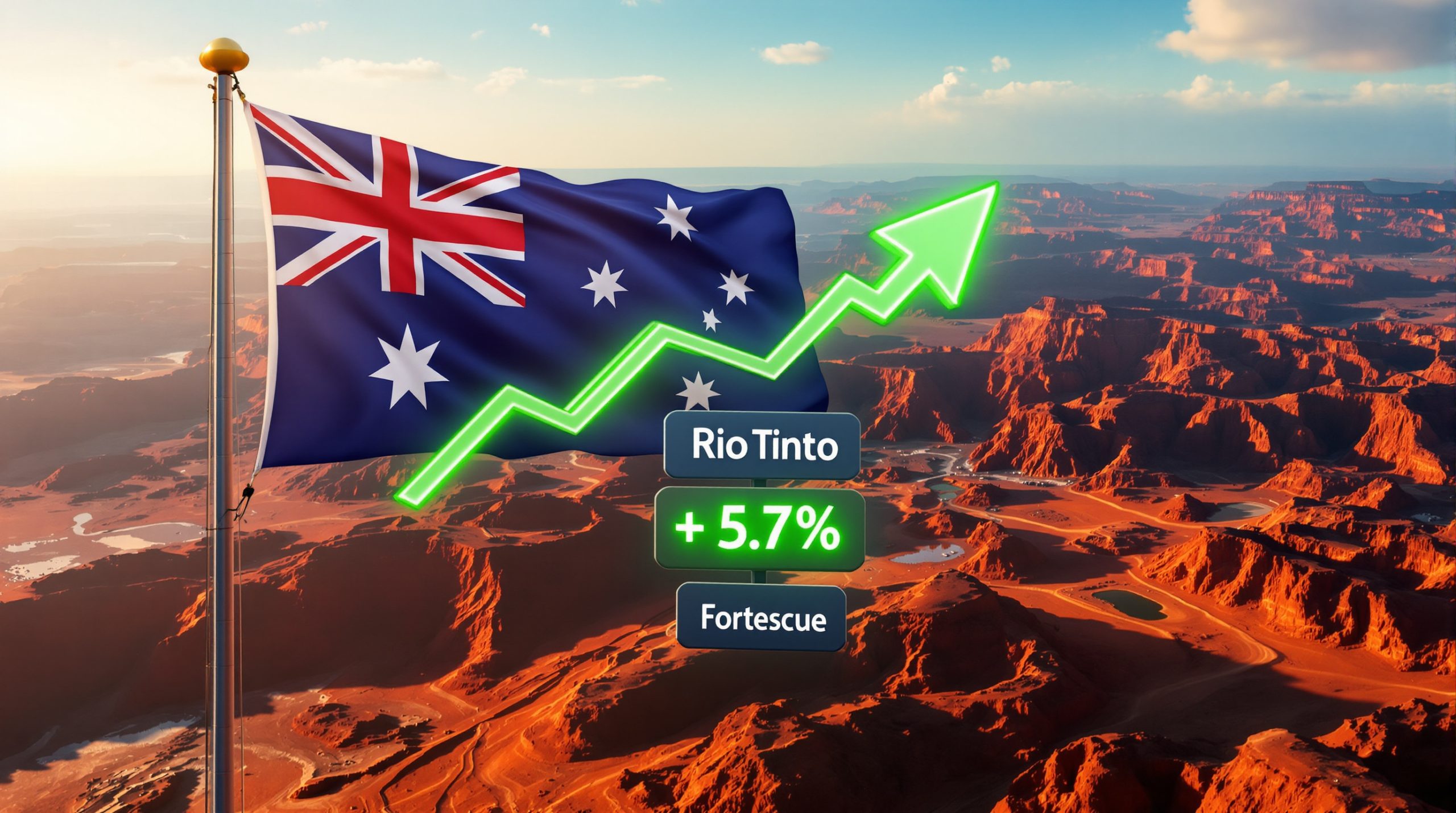How Did Rio Tinto Outperform Its ASX 200 Mining Rivals in September?
In a month where the broader S&P/ASX 200 Index retreated by 1.4%, the major Australian mining companies demonstrated remarkable resilience, with Rio Tinto mining shares performance September emerging as the standout performer. This analysis examines the September performance of Australia's three mining giants, exploring the market forces behind their movements and what investors should watch going forward.
September Performance Overview: The Big Three Mining Shares
The major ASX 200 mining companies all outperformed the broader market in September, with varying degrees of success:
| Company | September Performance | Adjusted Performance* |
|---|---|---|
| Rio Tinto (ASX: RIO) | +5.7% | +5.7% |
| BHP Group (ASX: BHP) | -1.5% | +0.6%* |
| Fortescue (ASX: FMG) | -3.2% | -0.1%* |
| ASX 200 Index | -1.4% | -1.4% |
*Adjusted performance accounts for dividend payments during September
What Drove Rio Tinto's Market-Leading 5.7% Gain?
Rio Tinto emerged as September's clear winner among the major mining stocks with a 5.7% share price increase, closing at $122.03 from $115.47 at August's end. This performance is particularly noteworthy as it occurred without any dividend adjustments during the month, representing pure price appreciation.
Key Growth Catalysts for Rio Tinto
Several factors contributed to Rio Tinto's strong September performance:
-
Strategic Copper Positioning: Rio Tinto's increased exposure to copper markets proved timely as copper price insights became more favorable with prices rising 3.9% during September, closing at US$10,269 per tonne.
-
Operational Efficiency Improvements: The company has been implementing cost-cutting measures and operational enhancements across its mining operations.
-
Investor Confidence: Despite market volatility, institutional investors showed continued confidence in Rio Tinto's management and strategic direction.
-
Supply Chain Resilience: Rio Tinto demonstrated stronger supply chain management compared to some competitors facing logistical challenges.
Resource Grade Advantages
Rio Tinto benefits from having some of the highest-grade iron ore deposits in its portfolio, particularly in the Pilbara region. Higher grade ore requires less processing, resulting in lower operational costs and higher profit margins when commodity prices fluctuate.
How Did BHP and Fortescue Perform After Dividend Adjustments?
BHP Group: Modest Gains After Dividend Adjustment
BHP shares initially appeared to decline 1.5% in September, closing at $42.53 compared to $43.19 at August's end. However, this figure doesn't tell the complete story.
BHP traded ex-dividend on September 4th, with a fully franked 91.9 cents per share final dividend. When adding this dividend back to the closing price:
$42.53 + $0.919 = $43.45
This adjusted calculation reveals BHP actually delivered a 0.6% gain for the month, outperforming the broader market's 1.4% decline. For more detailed analysis on ASX mining shares, Rio Tinto's dividend performance provides valuable insights.
Fortescue: Near-Breakeven After Dividend Consideration
Similarly, Fortescue shares showed a 3.2% decline at first glance, closing September at $18.68 compared to $19.30 at August's end. However, Fortescue also traded ex-dividend on September 1st with a fully franked 60 cents per share final dividend.
When accounting for this dividend payment:
$18.68 + $0.60 = $19.28
This adjusted calculation shows Fortescue shares essentially breaking even with just a 0.1% decline for the month – still significantly outperforming the broader market.
What Market Forces Supported Mining Share Performance?
Commodity Price Movements
Several commodity price movements influenced the mining sector's performance in September:
-
Iron Ore Price Strengthening: Iron ore price trends started September around US$102 per tonne but spent most of the month trading above US$105 per tonne, providing a foundation for all three mining giants.
-
Copper Price Rally: Copper prices increased by 3.9% during September, rising from US$9,884 to US$10,269 per tonne, particularly benefiting BHP and Rio Tinto with their significant copper operations.
-
Diversified Exposure: Rio Tinto's broader portfolio diversification may have provided additional buffers against specific commodity volatility.
Supply-Side Constraints
Ongoing supply constraints in key mining regions globally continued to support commodity prices. Labor shortages, equipment delays, and weather disruptions in competing markets like Brazil and South Africa created favorable conditions for Australian producers with more stable operations.
What Challenges Emerged for Australian Mining Companies?
Despite the generally positive performance, several headwinds emerged that could impact future performance:
Chinese Buying Pressure
Late September saw reports that China Mineral Resources Group (CMRG) was applying pressure on major iron ore producers, potentially including BHP and other Australian miners. Created three years ago to enhance China's bargaining power as the world's largest iron ore importer, CMRG's actions appear aimed at driving down iron ore prices.
This development remains an active concern moving into October and could impact pricing power for Australian iron ore producers. The China iron ore challenges continue to pose significant implications for the sector.
Resource Nationalism Concerns
Resource nationalism continues to emerge as a risk factor for mining operations globally. Several countries with significant mineral resources have been implementing more stringent regulations, higher taxation, and mandatory local ownership requirements that could affect future profitability of international operations.
Market Volatility Factors
Other factors contributing to market uncertainty included:
-
Global Economic Concerns: Broader economic growth questions continued to create uncertainty around future commodity demand.
-
Regulatory Developments: Increased scrutiny of mining operations and environmental impacts remained a consideration for investors.
-
Supply Chain Pressures: While improving, global logistics challenges continued to impact operational planning.
What Should Investors Watch Going Forward?
Key Indicators for Q4 2025
As investors look toward the final quarter of 2025, several factors will likely influence mining share performance:
-
Chinese Policy Developments: Further actions by CMRG and broader Chinese industrial policy will remain crucial for iron ore demand insights and pricing.
-
Copper Market Dynamics: Continued strength in copper prices could further benefit diversified miners like Rio Tinto and BHP.
-
Production Reports: Upcoming quarterly production reports will provide insights into operational efficiency and output volumes.
-
Decarbonization Initiatives: Progress on sustainability goals and green energy transitions may increasingly influence investor sentiment.
-
Merger and Acquisition Activity: Potential industry consolidation could impact competitive positioning among the major miners.
Technical Market Analysis
From a technical perspective, mining shares have formed interesting patterns heading into Q4. According to recent analyst recommendations, Rio Tinto appears to be testing new resistance levels after breaking above its 200-day moving average. BHP shows a consolidation pattern after its dividend payment, while Fortescue demonstrates support at key technical levels despite recent pressure.
How Are Mining Companies Positioning for Future Growth?
Strategic Initiatives
All three major mining companies are implementing strategic initiatives to enhance future performance:
-
Portfolio Optimization: Focusing capital on highest-return assets and divesting non-core operations.
-
Critical Minerals Focus: Increasing exposure to minerals essential for energy transition technologies.
-
Operational Technology: Implementing automation and digital solutions to improve productivity and safety.
-
ESG Commitments: Advancing environmental, social, and governance objectives to meet evolving stakeholder expectations.
Innovation in Mining Practices
The major miners are increasingly adopting mining sector innovation to enhance efficiency and sustainability:
-
Autonomous Operations: Rio Tinto leads the sector in autonomous drilling and haulage systems that improve safety and reduce operational costs.
-
Water Management: New water recycling and conservation technologies are being implemented to reduce environmental impacts in water-stressed regions.
-
Energy Transition: All three companies are investing in renewable energy projects to power their operations, with Fortescue making particularly aggressive commitments in this area.
Conclusion: Mining Sector Resilience Amid Market Uncertainty
September's performance demonstrated the resilience of Australia's major mining companies amid broader market weakness. Rio Tinto mining shares performance September standout 5.7% gain highlighted the benefits of its strategic positioning and operational execution, while both BHP and Fortescue showed strength when accounting for their dividend distributions.
While commodity price support provided tailwinds, emerging challenges from China's purchasing strategies and global economic uncertainty create a complex outlook. Investors should closely monitor these developments while considering the long-term strategic positioning of these mining giants in an evolving global resource landscape.
Disclaimer: This analysis contains general market commentary and is not intended as financial advice. Investors should conduct their own research and consider seeking professional advice before making investment decisions.
Further Exploration:
Readers interested in learning more about Australian mining sector performance can also explore related educational content, such as market analysis articles on ASX resources shares and commodity market trends.
Want to Spot the Next Major ASX Mineral Discovery?
Discover potentially transformative mineral announcements before the market reacts with Discovery Alert's proprietary Discovery IQ model, which instantly identifies high-potential ASX mining discoveries and converts complex geological data into actionable investment insights. Explore how historic discoveries have generated substantial returns by visiting the Discovery Alert discoveries page and position yourself ahead of the market.




